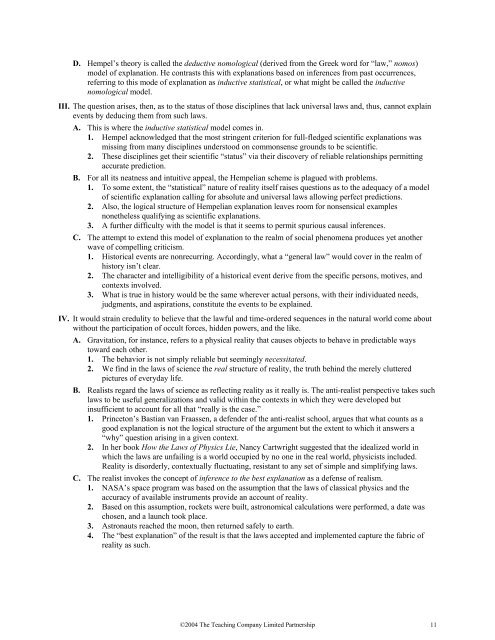Great Ideas of Philosophy
Great Ideas of Philosophy
Great Ideas of Philosophy
- No tags were found...
Create successful ePaper yourself
Turn your PDF publications into a flip-book with our unique Google optimized e-Paper software.
D. Hempel’s theory is called the deductive nomological (derived from the Greek word for “law,” nomos)model <strong>of</strong> explanation. He contrasts this with explanations based on inferences from past occurrences,referring to this mode <strong>of</strong> explanation as inductive statistical, or what might be called the inductivenomological model.III. The question arises, then, as to the status <strong>of</strong> those disciplines that lack universal laws and, thus, cannot explainevents by deducing them from such laws.A. This is where the inductive statistical model comes in.1. Hempel acknowledged that the most stringent criterion for full-fledged scientific explanations wasmissing from many disciplines understood on commonsense grounds to be scientific.2. These disciplines get their scientific “status” via their discovery <strong>of</strong> reliable relationships permittingaccurate prediction.B. For all its neatness and intuitive appeal, the Hempelian scheme is plagued with problems.1. To some extent, the “statistical” nature <strong>of</strong> reality itself raises questions as to the adequacy <strong>of</strong> a model<strong>of</strong> scientific explanation calling for absolute and universal laws allowing perfect predictions.2. Also, the logical structure <strong>of</strong> Hempelian explanation leaves room for nonsensical examplesnonetheless qualifying as scientific explanations.3. A further difficulty with the model is that it seems to permit spurious causal inferences.C. The attempt to extend this model <strong>of</strong> explanation to the realm <strong>of</strong> social phenomena produces yet anotherwave <strong>of</strong> compelling criticism.1. Historical events are nonrecurring. Accordingly, what a “general law” would cover in the realm <strong>of</strong>history isn’t clear.2. The character and intelligibility <strong>of</strong> a historical event derive from the specific persons, motives, andcontexts involved.3. What is true in history would be the same wherever actual persons, with their individuated needs,judgments, and aspirations, constitute the events to be explained.IV. It would strain credulity to believe that the lawful and time-ordered sequences in the natural world come aboutwithout the participation <strong>of</strong> occult forces, hidden powers, and the like.A. Gravitation, for instance, refers to a physical reality that causes objects to behave in predictable waystoward each other.1. The behavior is not simply reliable but seemingly necessitated.2. We find in the laws <strong>of</strong> science the real structure <strong>of</strong> reality, the truth behind the merely clutteredpictures <strong>of</strong> everyday life.B. Realists regard the laws <strong>of</strong> science as reflecting reality as it really is. The anti-realist perspective takes suchlaws to be useful generalizations and valid within the contexts in which they were developed butinsufficient to account for all that “really is the case.”1. Princeton’s Bastian van Fraassen, a defender <strong>of</strong> the anti-realist school, argues that what counts as agood explanation is not the logical structure <strong>of</strong> the argument but the extent to which it answers a“why” question arising in a given context.2. In her book How the Laws <strong>of</strong> Physics Lie, Nancy Cartwright suggested that the idealized world inwhich the laws are unfailing is a world occupied by no one in the real world, physicists included.Reality is disorderly, contextually fluctuating, resistant to any set <strong>of</strong> simple and simplifying laws.C. The realist invokes the concept <strong>of</strong> inference to the best explanation as a defense <strong>of</strong> realism.1. NASA’s space program was based on the assumption that the laws <strong>of</strong> classical physics and theaccuracy <strong>of</strong> available instruments provide an account <strong>of</strong> reality.2. Based on this assumption, rockets were built, astronomical calculations were performed, a date waschosen, and a launch took place.3. Astronauts reached the moon, then returned safely to earth.4. The “best explanation” <strong>of</strong> the result is that the laws accepted and implemented capture the fabric <strong>of</strong>reality as such.©2004 The Teaching Company Limited Partnership 11














